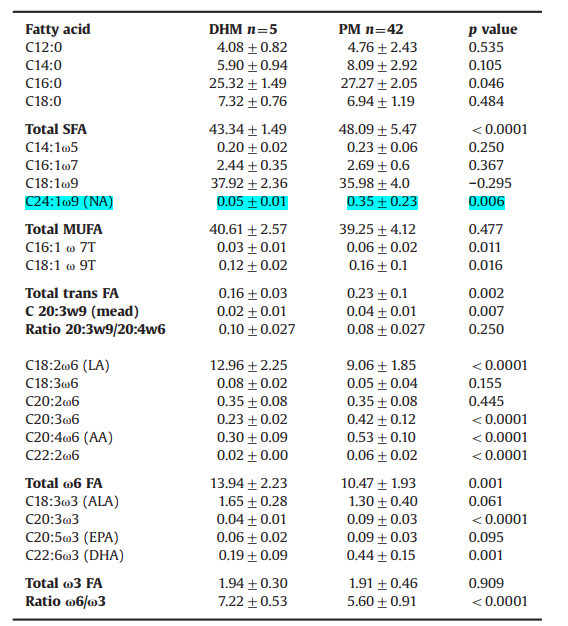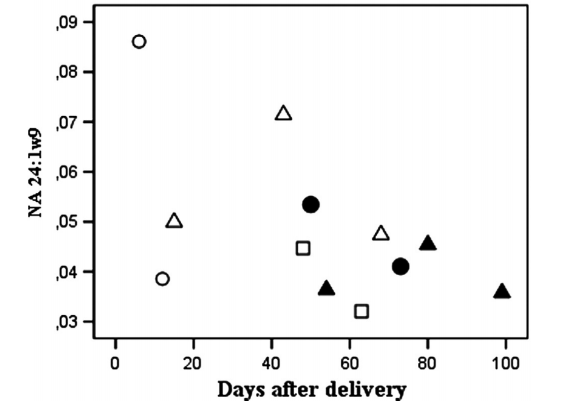In the study total brain volume was significantly related to the percentage of own mother's milk provided to the infants, as was the white matter volume for both absolute and relative brain volumes. Myelinisation is a key factor for brain volume increase. Nervonic acid (NA, 24:1ω9) is important for the development of the nervous system and early myelinisation, and impaired white matter can result in cerebral palsy. The supplementation of human milk with docosahexaenoic acid (DHA 22:6ω3) and arachidonic acid (AA, 20:4ω6) has been considered to contribute to a better psychomotor and cognitive development. The aim of this study was to underline the difference between DHM and milk of prematurely delivering mothers (PM) regarding NA and LCPUFA, in order to focus on preterm infant nutrition in a broader perspective.
The fatty acid (FA) concentrations were analyzed by gas chromatography in 12 samples of donor human milk (DHM) from five mothers, and compared to milk from 42 mothers delivering preterm infants. Fat, lactose and protein contents were compared.
The concentrations of major fatty acids (mol%) in donor human milk (DHM) and in milk from mothers to premature infants (PM). The mean+SD of DHM is based on mean from multiple samples of each donor mother (n=5). Independent samples’ ttest.
theconcentration of NA was seven times higher compared to DHM (p=0.006)

The concentrations of nervonic (NA) acids in 12 individual samples of donor human milk from five mothers in relation to the time of collection after delivery. The already low concentration of NA in DHM decreased even further during time of lactation.The samples from different mothers are indicated by different symbols

The much lower concentration of NA in DHM deserves special attention. NA is known to be found in sphingolipids of white matter and is used in the biosynthesis of myelin, isolating the neurons. Previous studies have addressed the question whether NA accumulation in sphingomyelin is important for cerebral myelination in premature infants. Babin et al. showed a remarkable increase of NA in red blood cell membranes between the 32nd to 37th gestational weeks. This increase was supposed to reflect brain maturity, which is supported by studies of glycerophospholipids and sphingomyelin in human brain tissue, showing a dramatic increase of NA in late gestation and early life. The study by Isaacs et al., showing strong correlation between the percentage intake of expressed own breast milk and white matter volume and later verbal and performance IQ, supports that early supply of NA, being important for myelinisation, may have long-term effects. One study has previously shown a marked decrease of NA in breast milk from colostrum to mature milk. Our results suggest a further decrease during the lactation period. Our results suggest that studies are warranted to investigate if DHM given to premature infants may require supplementation of nervonic acid, and not only LCPUFA, protein and minerals.
Nervonic acid is a necessary nutrient for brain development and maintenance function, which plays an important role in improving the activity of brain nerve and preventing the aging of brain nerve. Brain cells play a very important role in information transmission and information processing. Nervonic acid is one of the important components of brain nerve cell membrane. It can enhance the function of brain cell membrane by ingesting a small amount of nervonic acid every day. Enhance the connection, transmission and processing of information in the brain, enhance the memory function of the human body and promote the recovery of brain fatigue.



 Author:admin
Author:admin Updated Time:2020-10-29 13:06:33
Updated Time:2020-10-29 13:06:33 See Num:
See Num: